Venus Flytrap: Care, Feeding, Facts, Flowers (With Pictures)
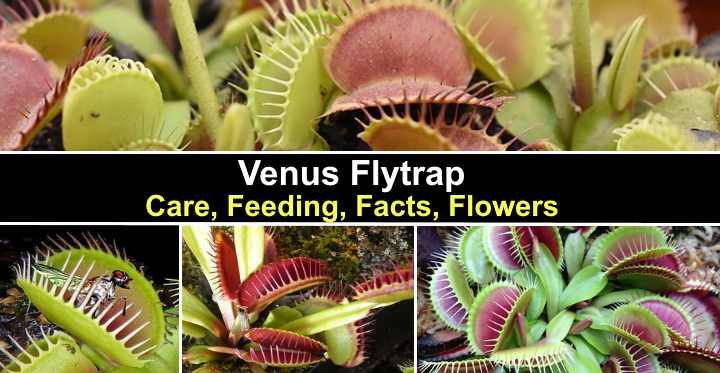
Venus flytrap is a popular carnivorous plant that traps insects before “consuming” them. The Venus flytrap uses sweet nectar to attract flies and insects to its two hinged lobes. When a fly, spider, or bug touches the fine bristles on the surface, the lobes close, trapping the insect. Fluids from the leaf tissue dissolve the insect, and the plant feeds by absorbing the insect’s nutrients.
From all the carnivorous plants, the Venus flytrap is one of the few to have visible movements to catch its prey. The clusters of toothed lobes that snap closed when an insect lands on it are fascinating to watch.
Caring for a Venus flytrap at home can be tricky. The unusual plant has some specific care needs when it comes to sun, moisture, and winter dormancy. However, you can successfully grow a Venus fly trap at home with the proper care so that you can enjoy watching this fascinating insect-eating plant.
This article is a guide to growing a Venus flytrap in a pot at home or in a warm sunny garden. In addition to a care guide, you’ll also learn about the other varieties of Venus flytraps available.
Venus Flytrap (Dionaea muscipula) Facts
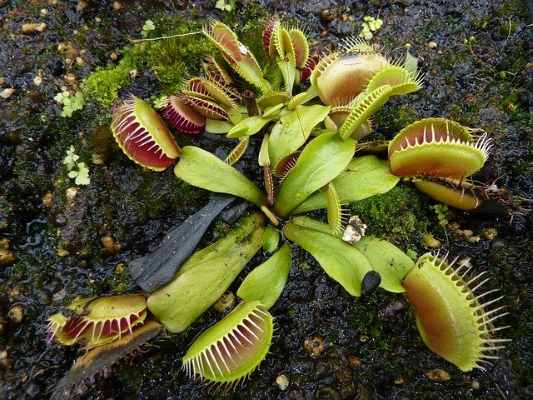
Venus flytrap (Dionaea muscipula) is a low growing flowering perennial plant
Venus flytrap is a perennial subtropical flowering plant in the genus Dionaea and family Droseraceae. Native to North Carolina and South Carolina, it is the only species in its genus. Outdoors, Venus flytraps only grow in USDA zone 8 to 10 in moist, acidic soil. Because they are a low-growing plant, they can be challenging to spot in the wild.
Venus flytraps have elongated heart-shaped leaves that have a hinged lobe at the end with toothed margins. The carnivorous plants grow in a rosette cluster of four to seven leaves. The stems grow 1.2” – 4” (3 – 10 cm) long, but they are mostly underground, with only the leaves showing. Leaves either lie flat on the ground or grow at a 40° to 60° angle.
The trap system on Venus flytraps is two circular lobes with spiny teeth along the margins. The surface of the lobes has tiny bristles that interlock when the trap closes. Depending on the species, the inside of the trap can be red, light burgundy, pink, green, or purple.
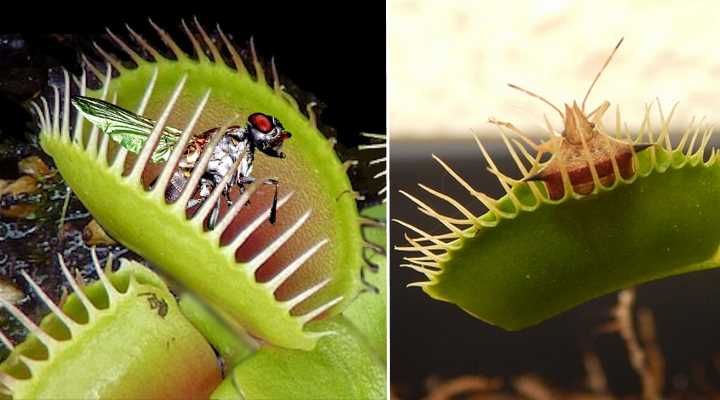
Venus flytrap lobes trap insects
An interesting feature of Venus flytraps is that they only close when an insect enters the “mouth” section. Usually, only when the delicate hairs inside the lobe are touched in quick succession, do the traps close shut. This way, the plant conserves energy and doesn’t react to raindrops or breezes.
A characteristic of Venus flytraps is that the stems of their flowers are longer than the plant’s “jaws.” The long flower stems grow approximately 6” (15 cm) long, double the length of the prostrate leaves. The growth feature ensures that the plants don’t trap pollinators but only crawling insects or non-pollinating flying insects.

Venus flytrap flower
Venus Flytrap Flower
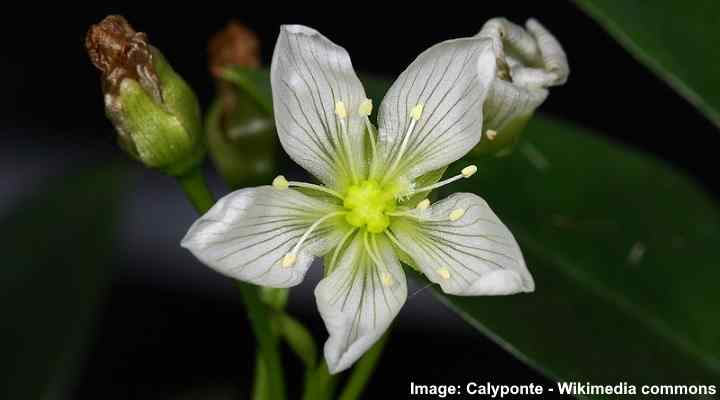
Close up picture of Venus flytrap flower
A Venus flytrap flower consists of five white ovate or obovate-shaped petals in a star shape and green stamens. The white flowers grow on the end of long upright stems and appear in late spring. After pollinating, the flytrap plant puts its energy into producing seeds to reproduce.
Should you allow a Venus flytrap to bloom? If you are caring for a Venus flytrap at home, it’s best to cut the flower stalk before it blooms. The stalk is a cylindrical stem that appears from the middle of the plant. If you allow the Venus flytrap to flower, it will have sluggish growth for most of the year. In some cases, cultivated plants can die after flowering.
How to Grow Venus Flytraps
To care for a Venus flytrap, grow the plant in pots with peat moss and perlite at a ratio of 2:1. Place on a sunny windowsill for best growth. Water regularly so the soil is constantly moist. During winter, keep the plant in cool temperatures, away from direct sunlight.
What Do Venus Flytraps “Eat”?
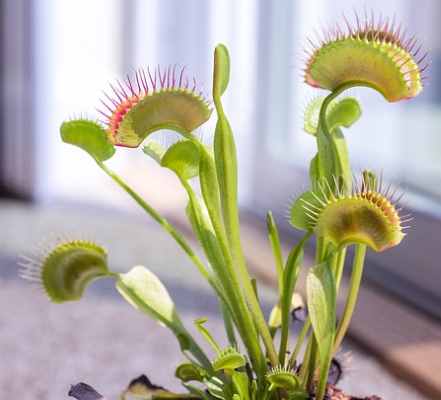
Venus flytrap feed on small insects and spiders
Venus flytraps “consume” small insects and spiders. A standard diet of Venus flytraps is ants, beetles, slugs, small caterpillars, flies, and even tiny frogs. After trapping its prey, a Venus flytrap secretes a liquid that breaks down the insect, taking three to five days. Then, it takes up to 12 days to finish the meal.
After feeding, the plant will open its trap, revealing the exoskeleton. This lures in the next unsuspecting insect, and the feeding process continues when the hungry plant traps its next victim. After around five meals, the trap no longer catches bugs, but it photosynthesizes before dropping off.
How to Feed Venus Flytrap?
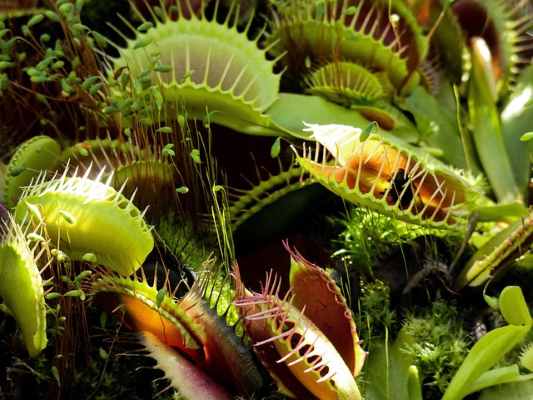
Avoid feeding Venus flytrap during its winter dormancy
You will need to catch flies or insects to feed your flytrap plant when growing it indoors. First, use a net to catch small bugs outdoors. Then using tweezers, gently brush the dead insect on one of the trap’s lobes. This should stimulate the lobes to close.
Alternatively, you can buy dried crickets, bloodworms, or mealworms to feed your bug-eating plant. Before serving the “meal,” rehydrate the worm or insect before feeding it to your plant.
After feeding the Venus flytrap, the lobes will stay closed for up to two weeks.
It’s vital not to overfeed a Venus flytrap, or it may die. The plant takes a long time to digest one insect, and you only feed one single trap of the whole plant. Then let the plant rest for a week or two between feedings.
There should always be one bug feeding at a time. So if you have six or eight traps or more, you may have to feed each individual trap once every week or two.
Here are a few handy tips when it comes to feeding a Venus flytrap:
- Don’t overstimulate the traps too much if you’re not feeding them. They only open and close up to ten times.
- Avoid feeding Venus flytrap plants during winter dormancy.
- Only feed the plant dead or living insects, never raw meat.
- If there are many traps on your plant, at least one trap should always be feeding on an insect.
How Long Do Venus Flytraps Live?
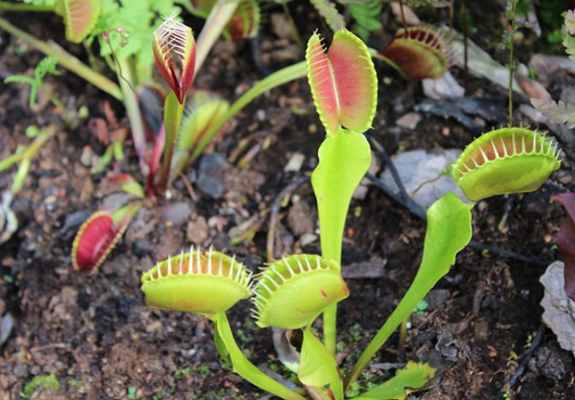
Venus flytrap can live up to 20 years
A Venus flytrap has a lifespan of up to 20 years under the right conditions. The Venus flytrap is a perennial subtropical plant and will grow year after year. A trap will open and close several times before dying. The plant will then grow a new underground stem.
Where Do Venus Flytraps Live?
In their natural habitat, Venus flytraps live in moist, loamy ground in the coastal plains and Sand hills of North and South Carolina. Generally, Venus flytrap plants grow in longleaf pine uplands where the ground is damp and of poor quality. However, the plants have also been introduced to some parts of Florida and Washington State.
Indoors, a Venus flytrap grows in a place where it gets full sun most of the day, for example, on your sunniest windowsill. Too much shade will cause the leaves to wilt and lose their energy. You can also grow the insect-loving plant in a closed terrarium. However, you need to ensure it gets plenty of light and has a dormant period in the winter.
How Big Do Venus Flytraps Get?
Venus flytraps grow up to 5” (13 cm) in diameter. Usually, a single leaf only measures around 1” (2.5 cm). Under good growing conditions, the small predatory plant can have between eight and 20 traps. Every so often, a trap will drop off, and a new one grows in its place.
Winter Dormancy for Venus Flytraps
For a Venus flytrap to grow year after year, it needs three to five months of winter dormancy. During the winter period, the leaves turn black and die. Therefore, you should place the potted plant in a cool, unheated location from late fall until early spring. Ideally, temperatures between 50°F and 35°F (10°C and -1°C) are perfect.
Keep the soil damp during the winter months, but don’t feed the plant with insects because it’s resting. When the temperatures start to warm over 50°F (10°C), place the plant in a sunnier location. Cut off any dead leaves. The plant will then start to grow again, ready to catch more bugs.
Varieties of Venus Flytrap Plants
There are many varieties of Venus flytrap plants, each with its traits and characteristics. Here are a few interesting types of Venus flytraps:
- Red Dragon—This spectacular insect-catching plant has deep red leaves, lobes, and long dark red thin spiny teeth.

Venus flytrap ‘Red Dragon’
- Justina Davis—All the leaf parts, including the two circular spiny lobes, are light green.

Venus flytrap ‘Justina Davis’
- Flaming Lips—The characteristic feature of this Venus flytrap is bright red lobes with a lime-green margin and sharp-looking teeth.
- Red Piranha—The burgundy-red leaves and lobes create a dramatic effect with this carnivorous plant.
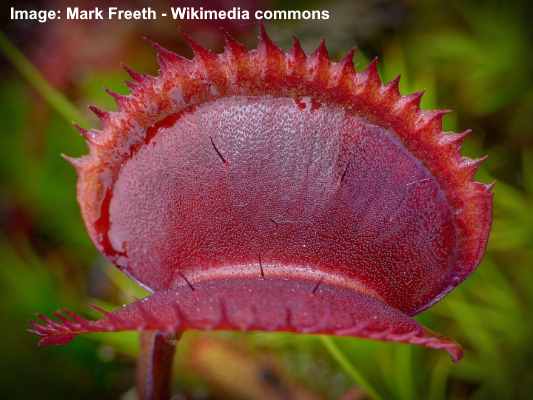
Venus flytrap ‘Red Piranha’
- Sawtooth—The identifying trait of this Venus flytrap plant is green-toothed lobes with deep red shading on the inside.
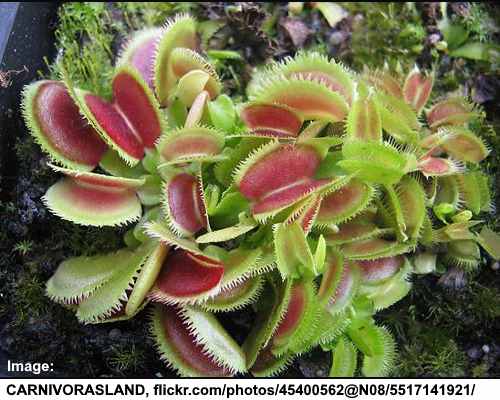
Venus flytrap ‘Sawtooth’
Venus Flytrap (Dionaea muscipula) Care Guide
A healthy Venus flytrap needs specific growing conditions to thrive. Proper care for the Venus flytrap plant involves growing it in sphagnum peat moss, using distilled water when watering, and keeping it in bright sunlight. Let’s look in more detail at how to grow a Venus flytrap in a pot.
Venus Flytrap Soil
To ensure healthy growth, always grow a Venus flytrap in a mineral-free, nutrient-free potting mix. The typical compost mixture for the plant is two parts sphagnum peat moss and one part perlite. This soilless potting mix contains few nutrients and has excellent moisture retention—ideal for a thriving Venus flytrap.
Alternatively, you can use a carnivorous plant soil specially formulated for plants that feed on insects and bugs as an appropriate potting medium.
Never plant a Venus flytrap in regular potting soil. Soil from the garden or a nutrient-rich potting mix contains too many minerals that can cause the plant to lose its vigor and die.
Lights Requirements for Growing Venus Flytrap
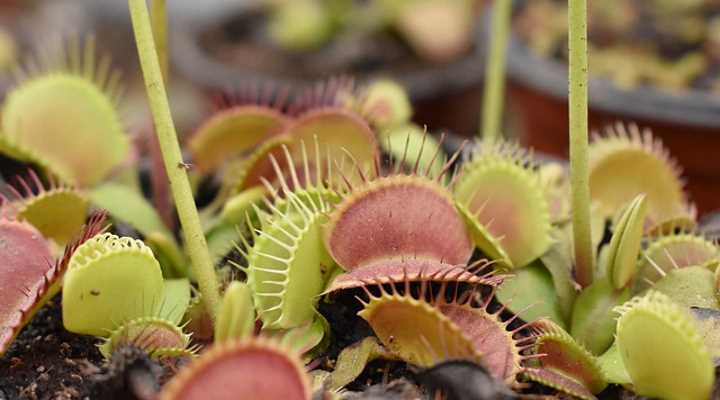
Grow Venus flytrap in a sunny location where it gets at least six hours of daily sunlight
Venus flytrap plants require at least six hours of sunlight a day to thrive. Therefore, the best place to grow the fly-catching plant is on a south-facing windowsill. You can also use a suitable plant grow light to ensure the carnivorous plant grows well.
Although a Venus flytrap is a suitable terrarium plant, it’s vital to supply enough light. This can sometimes be a challenge in a crowded glass enclosure. However, the constantly damp conditions and moist soil can benefit the plant if it gets enough sunlight daily.
But it’s good to remember that direct sunlight on a glass terrarium could cause the temperature to become too high and lead to leaf burn.
How to Water a Venus Fly Trap
When watering a Venus flytrap, always use mineral-free water. It is OK to use reverse osmosis water, rainwater, deionized water, or distilled water. However, tap water contains minerals and chemicals that can harm your carnivorous plant’s growth. In addition, water the soil often enough so that it is always moist.
To water a Venus flytrap, sit the pot on a saucer of water for a few hours each day. It is best not to water the soil from the top. As a rule, never let the soil dry out—even partially—otherwise, you risk stressing the moisture-loving insect eater plant, and it could eventually die.
Some people keep the Venus flytrap plant pot constantly in 0.4” (1 cm) of distilled water.
In winter, during dormancy, the soil needs to be kept damp but never too moist. Therefore, you don’t need to set it in water continuously.
Venus Fly Trap Temperature and Humidity Requirements
A Venus flytrap requires at least 60 percent relative humidity to flourish. If you sit the potted Venus flytrap on a water tray, the evaporating water will help provide humidity. Or you can grow the fly-catching plant near other houseplants to create a humid atmosphere.
The ideal temperature range for Venus flytrap plants is 70°F to 95°F (21°C – 35°C). During the winter dormancy period, the temperature should be between 40°F and 50°F (5°C – 10°C) to allow the tropical plant to rest. A Venus flytrap can stand light frosts at 35°F (-1°), but long spells below freezing could kill the plant’s roots.
Venus Flytrap Fertilizer
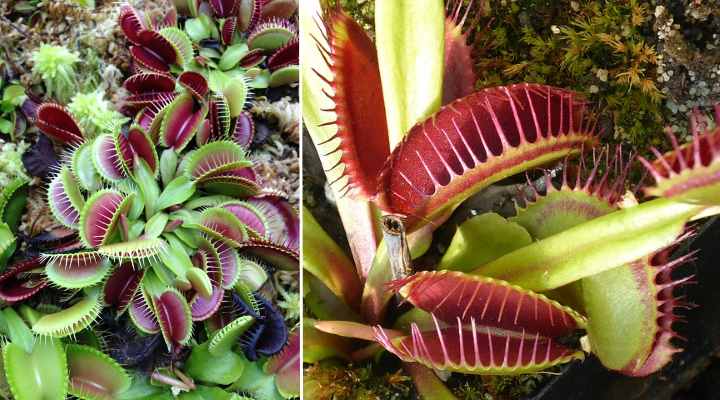
Venus flytrap plants don’t require any fertilization
Venus flytraps don’t require any kind of tropical plant or houseplant fertilizer. Instead, the plant thrives in poor soil and gets nutrients from a steady diet of spiders, grasshoppers, beetles, and other bugs.
Repoting a Venus Flytrap
Venus flytraps benefit from annual repotting to help keep the potting medium fresh and aerated. The best time to repot Venus flytraps is during spring or early summer when they come out of their winter dormancy.
When removing the old soil of the Venus flytrap, check the bulbous rhizomes for root rot and remove affected parts. This is when you can check if you can divide the Venus flytrap into multiple plants for propagation.
Venus Flytrap Propagation
The easiest way to propagate a Venus flytrap plant is to divide the roots in late winter. To propagate the plant, remove it from the pot and look for an offshoot with its own root system. You can then repot the plants in new pots.
You can also peel a leaf off from the root system to start a new plant. It’s good to remember that the leaf stem is underground. So, you will have to remove the soil from the roots to find a suitable leaf to remove. After removing the leaf, put it in a sphagnum moss and perlite mix. It will take about two years to produce a mature Venus flytrap plant.
Pests Affecting Venus Flytrap Growth
The primary pests affecting Venus flytraps are aphids and fungus gnats. Unfortunately, aphids are too small for the plants to catch, and Venus flytraps don’t constantly trap every tiny fly that buzzes around it. The good news is that aphids rarely cause any severe damage to Venus flytraps.
To get rid of aphids, submerge the plant in water for two to three days. After a week, repeat the treatment.
Fungus gnat larvae can cause damage to Venus flytrap plants by feeding on the plant’s stems and leaves. The best way to control fungus gnats is by applying Bacillus thuringiensis (Bt). The soil bacteria disrupt the lifecycle of the gnat larvae, eventually killing them for good.
Diseases Affecting Venus Flytrap Growth
Because Venus flytraps thrive in high humidity and moist soil, gray mold (Botrytis cinerea) can be an issue if the temperature is too cool. The grayish moldy spots can cause the leaves to wilt and die. The best way to deal with plant mold is to remove any infected leaves and put the plant in a warm, sunny spot.
Venus Flytrap Care – FAQs
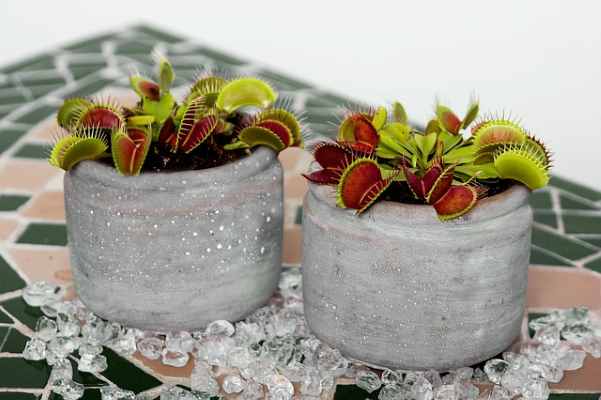
Is it normal for Venus flytrap leaves to die?
Venus flytrap leaves die every year as they enter winter dormancy. This is entirely natural, and you don’t have to worry. However, leaves may wilt and die if you over-feed the plant, use the incorrect water in the soil, allow the ground to dry out, or don’t ensure a resting time of three to four months during winter.
What does an unhealthy Venus flytrap look like?
A Venus flytrap that is stressed can lose its color, develop deformed leaves, or the leaves could start turning black. The most common reason Venus flytrap plants die is due to overly-rich soil, poor watering, or lack of sunlight. To revive a dying Venus flytrap, it’s vital to address the growing issues.
If necessary, change the soil and ensure that the potting mix is a peat moss and perlite combination. Also, only use distilled water or rainwater to keep the soil moist, and ensure the Venus flytrap gets plenty of sunlight by placing it on your sunniest windowsill.
What happens if my Venus flytrap plant goes black?
It’s normal for Venus flytrap leaves to turn black as winter approaches. During the months of dormancy, the leaves will be black as the plant rests. You can remove all dead leaves in spring, and new leaves should grow from the underground stems.
Related articles:
- Unique, Cool, and Unusual Houseplants
- The Most Amazing Colorful Houseplants
- The Best Closed Terrarium Plants
